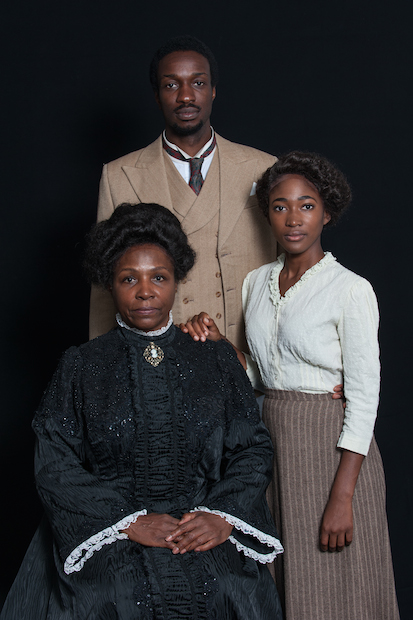As a political act, the first performance of Angelina Weld Grimké’s Rachel in 1916 is exceptionally important. It was staged in Washington DC by the drama committee of the National Association for the Advancement of Colored People, and was the first play by an African-American woman ever to be professionally produced (as well as one of the first to feature an all-black cast).
As drama, though, it does not quite measure up. The themes it features - segregation, racism, insidious intolerance - are undoubtedly powerful and too-little discussed on the stage. Yet the play’s dialogue is plodding, often awkward and over-full of exposition, and the structure is repetitive and sterile.
Seeing the play revived now is a strangely conflicting experienceThe action takes place in the living room of Mrs Loving (Miquel Brown, pictured below left with Zephryn Taitte and Adelayo Adedayo), a dressmaker who lives in a northern American city in the early 20th century. At the outset, all is positive, despite their relative poverty - her two children, Rachel and Tom, are well-educated and hopeful of their prospects, and she has enough work to keep them comfortably. But on the ten-year anniversary of her husband’s death, she decides to tell her children the truth: their father and half-brother were murdered by a white mob in a southern town. The long narration of the terrible story is compelling, but the characters’ reaction to it is typical of the weak dialogue in this play - after hearing how his father died, Tom absurdly leaps up and yells “I see red!” to indicate his anger. The play is so word-heavy that there is very little space left for any really emotional acting - it feels long, too, mostly because the characters are constantly delivering long, expository monologues to each other.
 The teenage Rachel, from whom we have already heard a lengthy, quasi-religious exhortation to her future calling as a mother, is affected differently by her mother's revelation. She reasons that if her half-brother grew up only to be killed, there must be thousands of brown babies all across the south who risk the same fate - wouldn’t it be better if they had never been born?
The teenage Rachel, from whom we have already heard a lengthy, quasi-religious exhortation to her future calling as a mother, is affected differently by her mother's revelation. She reasons that if her half-brother grew up only to be killed, there must be thousands of brown babies all across the south who risk the same fate - wouldn’t it be better if they had never been born?
This idea grows and twists inside her as she gets older, adopts an orphaned child from elsewhere in their apartment block, fails to get a job because of endemic racism (even in their apparently liberal northern city), and is courted by a Mr Strong (Zephryn Taitte). Indeed, the play’s dark final scene, where Rachel’s preoccupation eventually resurfaces, is the only really riveting bit.
Adelayo Adedayo as Rachel is at the centre of the action and, although her character is required to do endless dishing up of food and clearing of plates, manages to sketch her transition from idealism to despair pretty well. With so many monologues to deliver and listen to in turn, though, it’s hard to find any depth in any of the other characters, despite stalwart efforts from the rest of the cast. It is worth saying, though, that the child actors manage extremely well with such a dense script - little Jimmy got most of the few laughs for his antics.
This is the European Premiere of Rachel’s revival, having been rediscovered by Finborough Theatre Artistic Director Neil McPherson, and is presented as part of Black History Month. Seeing it now is a strangely conflicting experience. Part of the reason it was staged in 1916 was as a response to a recent film, The Birth of a Nation, which glorified the Ku Klux Klan and celebrated racism. As a document of a terrible oppression and a rare creative work by a woman, it is utterly worthwhile. But as a play, it lacks the verve and energy required to capture the imagination.















Add comment